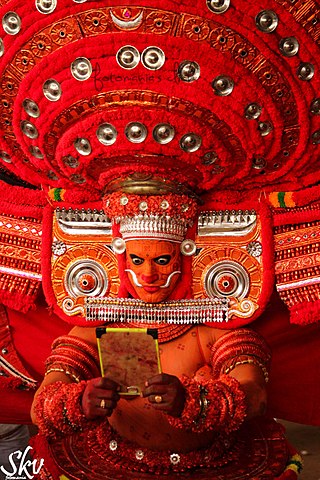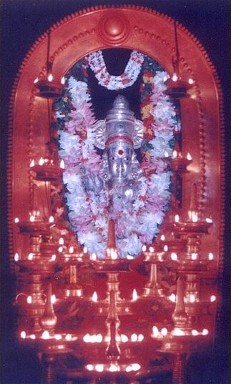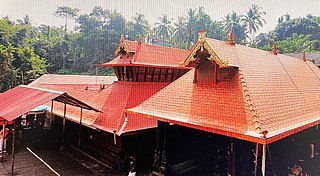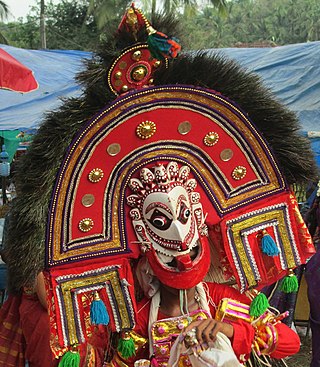
The Malayali people are a Dravidian ethnolinguistic group originating from the present-day state of Kerala in India, occupying its southwestern Malabar coast. They are predominantly native speakers of the Malayalam language, one of the six Classical languages in India. The state of Kerala was created in 1956 through the States Reorganisation Act. Prior to that, since the 1800s existed the Kingdom of Cochin, the Kingdom of Travancore, Malabar District, and South Canara of the British India. The Malabar District was annexed by the British through the Third Mysore War (1790–92) from Tipu Sultan. Before that, the Malabar District was under various kingdoms including the Zamorins of Calicut, Kingdom of Tanur, Arakkal kingdom, Kolathunadu, Valluvanad, and Palakkad Rajas.

Theyyam are Hindu Shamanic ritualistic dance forms practiced in northern Kerala and some parts of Karnataka. Theyyam is also known as Kaḷiyāṭṭaṁ or Tiṟa. Theyyam consists of traditions, rituals and customs associated with temples and sacred groves of Malabar. The people of the region consider Theyyam itself as a channel to a god and they thus seek blessings from Theyyam.

The culture of Kerala has developed over the past millennia, influences from other parts of India and abroad. It is defined by its antiquity and the organic continuity sustained by the Malayali people. Modern Kerala society took shape owing to migrations from different parts of India and abroad throughout Classical Antiquity.

Garudan Thookkamis a ritual art form performed in certain Kali temples in some Central Kerala districts in south India. The people who dress up as Garuda perform the dance. After the dance performance, the hang-designate dangle from a shaft hooking the skin on his back. In some places, the ritual is performed colorfully with Garudas taken in a procession on bullock carts or boats or hand pulled carts. It will be available in Devi temple during the festival of Meena bharani and Pathamudayam in Thiruvanchoor in Kottayam district.

Margamkali is an ancient Indian round dance of the St. Thomas Christians community- based in Kerala state, mainly practiced by the endogamous sub-sect known as the Knanaya or Southist Christians. The dance retells the life and missionary work of Thomas the Apostle, based on the 3rd-century apocryphal Acts of Thomas.

Manapullikavu is a Hindu temple located in Palakkad city, Kerala of India. The temple is most famous for the annual festival that takes place in the temple known as Manappullikavu Vela. Manapullikavu is also a major residential area in Palakkad city comprising apartments and residential colonies. Manappulikavu is ward 27 of Palakkad Municipality.

Kanniyar Kali is a folk dance ritual performed in Temples of villages in Alathur and Chittur Taluk of Palakkad district of Kerala. The event is usually a part of Vishu celebrations of the village and usually succeeds the Vela and is usually performed during the months of April and May. It is an agricultural festival dance of Nair community. Kanniyar Kali, despite the name of the Virgin, does not have anything to do with the Kannaki cult.
Tamil Nadu has a rich history of art and entertainment. The three modes of entertainment classified as Iyel (Literature), Isai (Music) and Nadagam (Drama) had their roots in the rural folk theatre like Theru Koothu. Many forms of group and individual dances with the classical forms for popularity and sheer entertainment value. Some of the dance forms are performed by Tribal people. The majority of these dances are still thriving in Tamil Nadu today.

Poothan and Thira is a ritualistic folk art performed mainly in the Valluvanad region of central Kerala in India, in which people dance in costumes representing Poothan is the lieutenant of Kali, and Thira, the goddess Kali, to the accompaniment of drummers. Thudi a small drum using for poothan, and heavy drum para accompanying thira.

Kummattikali or Kummatti Kali is the famous colorful mask-dance of Kerala, prevalent in Thrissur District, Palakkad District and parts of South Malabar. During the festival of Onam, Kummattikali performers move from house to house collecting small gifts and entertaining people. Kummatti dances are rampant in the Thrissur district during Onam. Pristine or original form of Kummattikali can be seen in the Bhadrakali temple in Palakkad district. Kerala

Kadampuzha Devi Temple is a Hindu temple and pilgrimage center at Kadampuzha in Malappuram district, Kerala, India. The main deity of this temple is Goddess Parvati/Durga in the form of a huntress. There is no idol of Goddess in this temple, and she is worshipped in a pit. The presence of Lord Ganesha is also believed to be with the Goddess, and there are sub-shrines for Lord Sastha and serpent deities. A separate Shiva temple exists near the temple, called 'Madambiyarkavu'. Both these temples are under the control of Malabar Devaswom Board.

North Malabar refers to the geographic area of southwest India covering the state of Kerala's present day Kasaragod, Kannur, and Wayanad districts, and the taluks of Vatakara, Koyilandy in the Kozhikode District of Kerala and the entire Mahé Sub-Division of the Union Territory of Puducherry. Traditionally North Malabar is defined as the northern portion of erstwhile Malabar District which lies between Chandragiri River and Korapuzha River. The region between Netravathi River and Chandragiri River, which included the portions between Mangalore and Kasaragod, are also often included in the term North Malabar, as the Kumbla dynasty in the southernmost region of Tulu Nadu, had a mixed lineage of Malayali Nairs and Tuluva Brahmins.

Thidambu Nritham is a Hindu ritual dance performed in Temples of North Malabar in India. It is mainly performed by Namboothiris and rarely other Brahmin, Thiyyar communities like Shivalli, Karhade and Havyaka.

Parichamuttu Kali is an Indian martial-arts dance form of Kerala practiced by the Saint Thomas Syrian Christians who trace their origins to the evangelistic activity of Thomas the Apostle in the 1st century. It is performed by men bearing swords and shields and follows the movements and steps of Kalarippayattu. This dance is closely related to Margam Kali. Parichamuttu Kali was also performed by Harijans.

Poothamkali is folk art form in state of Kerala, India. This art form uses various types of decorations in the costume. It is usually performs in the Bhagavathy temples of Malappuram district. It is based on the myth of durga and her combat with Darika asura.
Malavazhiyattam also known as MalavayiyattamKariniliyattam or Cheruniliyattam is a ritualistic folk art of the Paraya community in Kerala, India. Malavazhi is a mother goddesses installed in the homes of the Parayas and worshiped by them. Malavazhiyattam or Cheruniliyattam is performed to please the deities through music and drama.
Ninabali is a ritualistic performing art form popular in Kannur, Kozhikode districts of northern Kerala, India. It is a folk art performed by the Malaya community. This art form, which is performed in homes as part of Hinuist exorcism ceremonies, depicts the battle between Bhadrakali and the asura Darika.

Chozhikali, also spelled as Chozhi Kali, is a folk dance popular in Central Kerala, India. There are two types of Chozhikali: Thiruvathirachozhi and Kudachozhi. It is performed by the Hindu community in Palakkad and Thrissur districts of Kerala.

Nayadikali is a traditional folk art form that exists among the Panan community of the Valluvanad region in Kerala, India. It is usually performed ahead of the Pooram festival at the Devi temples in the region, for the good and prosperity of the people and region.
















